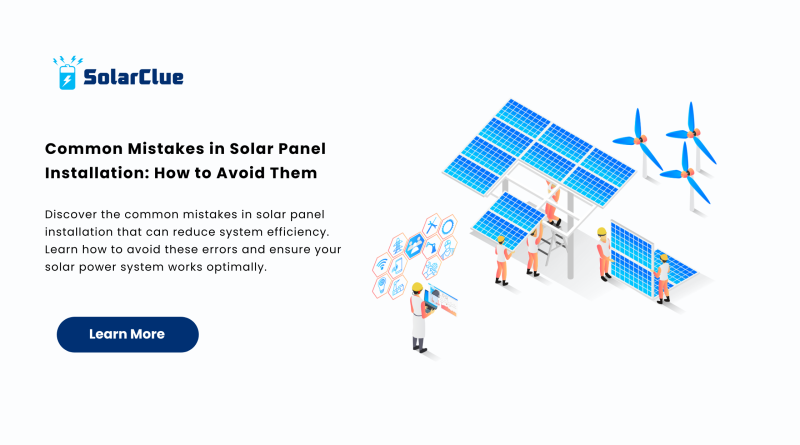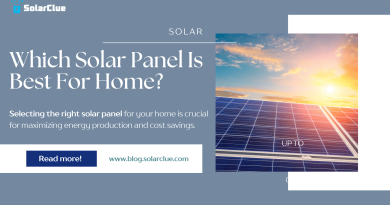Common Mistakes in Solar Panel Installation: How to Avoid Them
Solar power systems are a great way to harness renewable energy and reduce electricity bills. However, improper solar panel installation can result in decreased efficiency, increased maintenance costs, and even premature system failure. In this blog, we will walk through the most common solar installation mistakes and provide solutions on how to avoid them, ensuring your solar panel system performs optimally for years.
Table of Contents
- 1 1. Incorrect Panel Orientation and Tilt Angle
- 2 2. Inadequate Roof Space and Structural Integrity
- 3 3. Failure to Account for Shading
- 4 4. Poor Wiring and Electrical Connections
- 5 5. Neglecting the Solar Inverter
- 6 6. Ignoring Proper Permitting and Regulations
- 7 7. Using Low-Quality Panels or Equipment
- 8 8. Not Considering Future Expansion
- 9 9. Incorrect Sizing of the System
- 10 10. Poor Maintenance and Monitoring
- 11 FAQs
- 12 Conclusion
1. Incorrect Panel Orientation and Tilt Angle
One of the biggest mistakes in solar panel installation is poor panel orientation and tilt angle. Solar panels need to be installed at the right angle to maximize energy production. If the panels are not properly oriented towards the sun or tilted at an optimal angle, their performance can be significantly reduced.
Solution: Proper Orientation and Angle
To avoid this mistake, always make sure that the panels face true south (in the Northern Hemisphere) and are tilted at an angle that matches the latitude of the installation location. This will ensure they receive the maximum amount of sunlight.
2. Inadequate Roof Space and Structural Integrity
Another common issue is insufficient roof space or structural weakness. Solar panel installation requires a sturdy roof with enough space to accommodate the panels. Installing panels on a weak or small roof can cause problems in the long run, such as roof damage and inefficient solar panel performance.
Solution: Roof Assessment
Before proceeding with solar panel installation, ensure the roof is strong enough to support the system. A professional should inspect the roof for any damage and make sure there is enough space to install the panels without obstruction. If necessary, consider reinforcing the roof before installation.
3. Failure to Account for Shading
Shading can significantly reduce the output of your solar power system. Installing panels in areas that are frequently shaded by trees, buildings, or other obstacles will lead to energy loss, making the system less efficient.
Solution: Assessing Shading Before Installation
Carefully evaluate the installation site to ensure that the solar panel system will not be shaded during peak sunlight hours. If shading is unavoidable, consider using solar panels with built-in bypass diodes or optimizing the system with micro-inverters to reduce shading losses.
4. Poor Wiring and Electrical Connections
Improper wiring or loose electrical connections are common mistakes in solar panel installation that can lead to system malfunctions, fires, or even complete failure. The wiring must be done by a qualified professional to ensure that all connections are secure and properly insulated.
Solution: Professional Electrical Work
To avoid this mistake, always hire a licensed electrician for solar panel installation. They will ensure that the wiring and electrical connections are done correctly and safely. Proper grounding is also crucial to prevent electrical shocks or fire hazards.
5. Neglecting the Solar Inverter
The solar inverter is a critical component of any solar power system. It converts the DC electricity produced by the solar panels into AC electricity, which is used to power appliances in your home or business. Failing to choose the right inverter or neglecting its maintenance can cause your system to underperform.
Solution: Choosing the Right Inverter
When selecting an inverter, ensure it is compatible with your solar panel system in terms of capacity and efficiency. Additionally, regular maintenance of the inverter is necessary to keep it running efficiently. Be sure to check for software updates and any signs of wear or malfunction.
6. Ignoring Proper Permitting and Regulations
Many people skip or ignore the necessary permits and regulations when installing a solar panel system. This can lead to fines, the need for costly reinstallation, or even the removal of the panels. Each locality has different rules and guidelines for solar installation, which must be followed to avoid legal issues.
Solution: Ensure Compliance with Local Laws
Before beginning solar panel installation, check with your local government or utility company to determine the necessary permits and regulations. A professional installer will typically handle this step, but it’s always good to stay informed and ensure everything is up to code.

7. Using Low-Quality Panels or Equipment
Choosing cheap, low-quality solar panels or equipment can save money upfront but lead to increased costs down the road. Low-quality solar panels may degrade faster, resulting in a shorter lifespan and poor performance.
Solution: Invest in High-Quality Solar Panels
Always opt for high-quality solar panels from reputable manufacturers. While the initial cost may be higher, these panels typically come with better warranties and higher efficiency, providing a better return on investment in the long term.
8. Not Considering Future Expansion
Some homeowners and businesses fail to plan for future expansion when installing their solar power system. If you plan to increase your energy needs in the future, such as adding more appliances or electric vehicles, you might find your current system inadequate.
Solution: Plan for Future Growth
When designing your solar panel installation, consider the possibility of future energy demands. Leave room for additional panels, inverters, or batteries, and choose a system that can be expanded without major modifications.
9. Incorrect Sizing of the System
Another critical mistake is installing a solar power system that is either too small or too large for your energy needs. A system that is too small won’t meet your energy requirements, while one that is too large will result in unnecessary costs.
Solution: Accurate System Sizing
Work with a professional to correctly size your solar panel system based on your energy consumption. They will calculate the number of solar panels needed to meet your specific requirements and advise on whether additional storage (batteries) is necessary.
10. Poor Maintenance and Monitoring
Neglecting regular maintenance and monitoring of your solar panel system can lead to unnoticed problems, such as dirt buildup, wiring issues, or inverter failures. Regular inspections are essential for maximizing system performance.
Solution: Regular Maintenance and Monitoring
Schedule regular maintenance for your solar power system, and consider installing a monitoring system to track its performance. This will allow you to detect any issues early and ensure your system operates at peak efficiency.
FAQs
Q1: How can I avoid shading issues in my solar panel installation?
To avoid shading, choose an installation location that is free from obstructions during peak sunlight hours. If shading is unavoidable, consider using micro-inverters or solar panels with bypass diodes to mitigate losses.
Q2: What is the best angle to install solar panels?
The optimal angle for solar panels is usually equal to the latitude of your location. For example, if you live at 30° latitude, install your solar panels at a 30° tilt for maximum efficiency.
Q3: Can I install solar panels on a roof with limited space?
Yes, but careful planning is required. You may need to optimize the available space or consider installing panels on a ground-mounted system if roof space is limited.
Q4: How often should I clean my solar panels?
Solar panels should be cleaned every 6-12 months, depending on the dust levels in your area. In some locations with heavy pollution or dust, more frequent cleaning may be necessary.
Conclusion
Installing a solar panel system is a great investment, but it’s important to avoid common mistakes that could hinder its performance and longevity. By ensuring proper installation, maintenance, and planning, you can maximize the benefits of your solar power system and enjoy reliable, clean energy for years to come.
To learn more about solar panel installation or get expert guidance on setting up a solar power system, visit solarclue.com or check out our blog at blog.solarclue.com.



